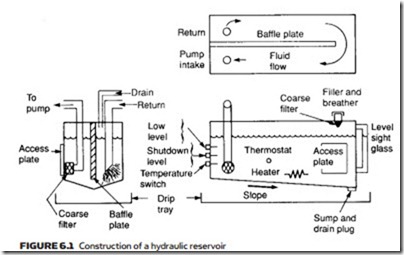Hydraulic reservoirs
A hydraulic system is closed, and the oil used is stored in a tank or reservoir to which it is returned after use. Although probably the most mundane part of the system, the design and maintenance of the reservoir is of paramount importance for reliable operation. Figure 6.1 shows details of a typical reservoir.
The volume of fluid in a tank varies according to temperature and the state of the actuators in the system, being minimum at low temperature with all cylinders extended, and maximum at high temperature with all cylinders retracted. Normally the tank volume is set at the larger of four times the pump draw per minute or twice the external system volume. A substantial space must be pro- vided above the fluid surface to allow for expansion and to prevent any froth on the surface from spilling out.
The tank also serves as a heat exchanger, allowing fluid heat to be removed. To obtain maximum cooling, fluid is forced to follow the walls of the tank, from the return line to pump suction inlet, by a baffle plate down the tank center line.
Typically this baffle plate will be two-thirds of the height of the fluid surface. This plate also encourages any contamination to fall to the tank bottom before reaching the pump inlet, and allows any entrapped air to escape to the surface. The main return line should enter from the top of the tank to preclude the need for a check valve and end below the minimum tank level to prevent air being drawn into the oil. The return flow should emerge into the tank through a dif- fuser with a low velocity of around 0.3 m s-1 to prevent disturbance of any deposits at the base of the tank. The flow should be directed at the tank wall to assist cooling. Pump inlet lines should be at least 100 mm above the base of the tank to avoid debris being sucked into the pump.
If, as is commonly the case, the external components outside the tank are below the oil level in the tank the return line should be equipped with a removable anti-siphonage plug. This should be removed to allow air into the return line before any external components are disconnected. Without this precaution a siphon back-flow can occur which is very difficult to stop. If you have never encountered it before the sudden and apparently unstoppable flow of oil from the return pipe on disconnection can be very surprising.
Low-pressure returns (such as drains from motors or valves) must be re- turned above fluid level to prevent back pressure and formation of hydraulic locks.
Fluid level is critical. If it is too low, a whirlpool forms above the pump in- let, resulting in air being drawn into the pump. This air results in maloperation, and will probably result in pump damage.
A level sight glass is essential to allow maintenance checks to be carried out. The only route for oil to leave a hydraulic system is, of course, by leaks, so the cause of any gross loss of fluid needs investigation. In all bar the smallest and simplest systems, two electrical float switches are generally included, giving a remote (low-level) warning indication and a last ditch (very-low-level) signal which leads to automatic shutdown of the pump before damage can occur.
The temperature of fluid in the tank also needs monitoring and as an absolute minimum a simple visual thermometer should be included. The ideal temperature range is around 45–50 °C and, usually, the problem is keeping the temperature down to this level. Ideally an electrical over-temperature switch is used to warn the user when oil temperature is too high.
When the system is used intermittently, or started up from cold, oil temperature can be too low, leading to sluggish operation and premature wear. A low-temperature thermostat and electrical heater may be included to keep the oil at an optimum temperature when the system is not in use.
Reservoirs are designed to act as collecting points for all the dirt particles and contamination in the system and are generally constructed with a V-shaped cross-section forming a sump. A slight slope ensures contamination collects at the lower end where a drain plug is situated. Often magnetic drain plugs are used to trap metallic particles.
Reservoirs should be drained periodically for cleaning, and a removable man access plate is included for this purpose. This is not the most attractive of jobs!
Oil is added through a filler cap in the tank top. This doubles as a breather al- lowing air into and out of the tank as the volume of fluid changes. A coarse filter below the breather prevents contamination entering the tank as fluid is added.
Tank air filters are commonly forgotten in routine maintenance. The oil in a typical tank changes considerably during operation as temperatures change and actuators operate. This change in volume is directly reflected in air changes both in and out of the tank. The only route for this air flow is through the filters. If these become blocked the tank may become pressurized and fail disastrously.
Reservoirs are generally constructed from welded steel plate with thin side walls to encourage heat loss. The inside of the tank is shot blasted then treated with protective paint to prevent formation of rust particles.
At some time in the life of a hydraulic system there will eventually be oil spillage around the tank, whether from leakage, over-enthusiastic filling or care- less maintenance. It is therefore good practice to put substantial drip trays under reservoir pumps and associated valves to limit oil spread when the inevitable mishaps occur.
